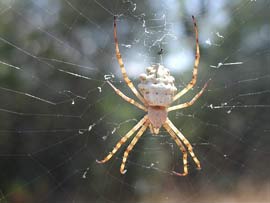How to identify harmful spiders on plant leaves?
Different from large-sized prey spiders, often with nets or crawling on flowers, leaves to catch insects that are useful species or also called natural enemy spiders, spiders harmful to plants have very small and difficult sizes. Observed with the naked eye, do not spread the net and often concentrate on the young leaves or fruit to suck the sap.
 The group of harmful spider plants is very rich and often causes harm on many crops but concentrates on the following species: Red spider, white spider, yellow spider, brown spider. If we observe under the magnifying glass, we see red spider with bright red color, bigger in size than other spiders.
The group of harmful spider plants is very rich and often causes harm on many crops but concentrates on the following species: Red spider, white spider, yellow spider, brown spider. If we observe under the magnifying glass, we see red spider with bright red color, bigger in size than other spiders.
White spider is white, smaller than red spider while yellow spider has yellow color and shape looks like carrot. White spiders and yellow spiders prefer to damage on young fruit by sucking plastic to break down essential oil bags (with citrus fruit group) forming brown-gray streaks called lumps while red spiders often harm young leaves. and the leaves of leaves make the leaves discolored, lose all chlorophyll, make the tree stunted, grow poorly due to no photosynthesis.
To identify the presence of harmful spiders, rely on the color of the leaves, pods and use of a hand magnifier with a magnification of 10 times to observe. The experience of many gardeners can use a blank sheet of paper against the face of the leaf to have spider and rub lightly on the paper. Open if there are red, yellow, or fluid streaks on the white paper (dead spiders leave behind traces of it on paper), then the leaf has been damaged by spiders. Based on the number of " blood stains " on the paper to determine the density and severity of spiders to take timely preventive measures.
- Identify spiders through software
- The whole weight of humans combined is not equal to the amount of food that spiders consume each year
- Spider 'sniffs' to identify 'safe' partner
- Discover giant spider as big as human face
- Harvard University developed artificial photosynthetic bionic leaves with higher performance than true leaves
- The red maple leaves have been hot these days but do you really know about this plant?
- Spiders re-solidify and birds
- Science has proven: Spider is a friend, not an enemy!
- Spiders have the ability to turn into amazingly perfect leaves
- Why leaves are red in autumn
- Many new and rare spiders are found in Australia and India
- Close-up of plants '3 leaves take a human life'
 'Barefoot engineer' invents a pipeless pump
'Barefoot engineer' invents a pipeless pump Process of handling dead pigs due to disease
Process of handling dead pigs due to disease Radiometer
Radiometer Warp Engine: Technology brings us closer to the speed of light
Warp Engine: Technology brings us closer to the speed of light